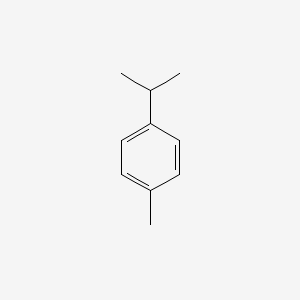| MeSH term | MeSH ID | Detail |
|---|---|---|
| Carbon Tetrachloride Poisoning | D002252 | 12 associated lipids |
| Chemical and Drug Induced Liver Injury | D056486 | 39 associated lipids |
| Dermatomycoses | D003881 | 17 associated lipids |
p-Cymene
P-cymene is a lipid of Prenol Lipids (PR) class. P-cymene is associated with abnormalities such as Abnormal shape. The involved functions are known as Binding (Molecular Function), inhibitors and Oxidation. P-cymene often locates in Cell membrane. The associated genes with p-Cymene are Chromatin, Homologous Gene and ethylbenzene dehydrogenase. The related lipids are Steroids.
Cross Reference
Introduction
To understand associated biological information of p-Cymene, we collected biological information of abnormalities, associated pathways, cellular/molecular locations, biological functions, related genes/proteins, lipids and common seen animal/experimental models with organized paragraphs from literatures.
What diseases are associated with p-Cymene?
p-Cymene is suspected in Abnormal shape and other diseases in descending order of the highest number of associated sentences.
Related references are mostly published in these journals:
| Disease | Cross reference | Weighted score | Related literature |
|---|
Possible diseases from mapped MeSH terms on references
We collected disease MeSH terms mapped to the references associated with p-Cymene
PubChem Associated disorders and diseases
What pathways are associated with p-Cymene
There are no associated biomedical information in the current reference collection.
PubChem Biomolecular Interactions and Pathways
Link to PubChem Biomolecular Interactions and PathwaysWhat cellular locations are associated with p-Cymene?
Visualization in cellular structure
Associated locations are in red color. Not associated locations are in black.
Related references are published most in these journals:
| Location | Cross reference | Weighted score | Related literatures |
|---|
What functions are associated with p-Cymene?
Related references are published most in these journals:
| Function | Cross reference | Weighted score | Related literatures |
|---|
What lipids are associated with p-Cymene?
Related references are published most in these journals:
| Lipid concept | Cross reference | Weighted score | Related literatures |
|---|
What genes are associated with p-Cymene?
Related references are published most in these journals:
| Gene | Cross reference | Weighted score | Related literatures |
|---|
What common seen animal models are associated with p-Cymene?
There are no associated biomedical information in the current reference collection.
NCBI Entrez Crosslinks
All references with p-Cymene
Download all related citations| Authors | Title | Published | Journal | PubMed Link |
|---|---|---|---|---|
| Gallucci MN et al. | In vitro activity of natural phenolic compounds against fluconazole-resistant Candida species: a quantitative structure-activity relationship analysis. | 2014 | J. Appl. Microbiol. | pmid:24387763 |
| Raal A et al. | Composition of the essential oil of the Rhododendron tomentosum Harmaja from Estonia. | 2014 | Nat. Prod. Res. | pmid:24716612 |
| Sarıkahya NB et al. | Phytochemical analysis of the essential oils of 10 endemic Cephalaria species from Turkey. | 2013 | Nat. Prod. Res. | pmid:22757667 |
| Zhang L et al. | Ru-catalyzed 1,4-addition of arylboronic acids to acrylic acid derivatives in the presence of phenols. | 2013 | Chem. Commun. (Camb.) | pmid:23961538 |
| Rajput SB and Karuppayil SM | Small molecules inhibit growth, viability and ergosterol biosynthesis in Candida albicans. | 2013 | Springerplus | pmid:23449869 |
| Belaqziz R et al. | Essential oil composition and antibacterial activity of the different parts of Thymus maroccanus Ball: an endemic species in Morocco. | 2013 | Nat. Prod. Res. | pmid:23425125 |
| Ferraz RP et al. | Cytotoxic effect of leaf essential oil of Lippia gracilis Schauer (Verbenaceae). | 2013 | Phytomedicine | pmid:23453306 |
| Chen Y et al. | A ruthenium(II) arene complex showing emission enhancement and photocleavage activity towards DNA from singlet and triplet excited states respectively. | 2013 | Dalton Trans | pmid:23459918 |
| Kuzma M et al. | New insight into the role of a base in the mechanism of imine transfer hydrogenation on a Ru(II) half-sandwich complex. | 2013 | Dalton Trans | pmid:23403772 |
| Petretto GL et al. | Chemical and biological study on the essential oil of Artemisia caerulescens L. ssp. densiflora (Viv.). | 2013 | Nat. Prod. Res. | pmid:23244627 |
| Lage TC et al. | Activity of essential oil of Lippia triplinervis Gardner (Verbenaceae) on Rhipicephalus microplus (Acari: Ixodidae). | 2013 | Parasitol. Res. | pmid:23224609 |
| Ogata K et al. | Position-selective intramolecular aromatic C-H bond activation of 1,2,3-triazol-5-ylidene (tzNHC) ligands in (p-cymene)ruthenium(II) complexes. | 2013 | Dalton Trans | pmid:23235553 |
| Mugnaini L et al. | A herbal antifungal formulation of Thymus serpillum, Origanum vulgare and Rosmarinus officinalis for treating ovine dermatophytosis due to Trichophyton mentagrophytes. | 2013 | Mycoses | pmid:23368893 |
| Quintans Jde S et al. | Improvement of p-cymene antinociceptive and anti-inflammatory effects by inclusion in β-cyclodextrin. | 2013 | Phytomedicine | pmid:23357360 |
| Kurzwernhart A et al. | 3-Hydroxyflavones vs. 3-hydroxyquinolinones: structure-activity relationships and stability studies on Ru(II)(arene) anticancer complexes with biologically active ligands. | 2013 | Dalton Trans | pmid:23168616 |
| Herzi N et al. | Comparison between supercritical CO2 extraction and hydrodistillation for two species of eucalyptus: yield, chemical composition, and antioxidant activity. | 2013 | J. Food Sci. | pmid:23551200 |
| Adeniyi AA and Ajibade PA | Comparing the suitability of autodock, gold and glide for the docking and predicting the possible targets of Ru(II)-based complexes as anticancer agents. | 2013 | Molecules | pmid:23529035 |
| Zhong W et al. | p-Cymene modulates in vitro and in vivo cytokine production by inhibiting MAPK and NF-κB activation. | 2013 | Inflammation | pmid:23207717 |
| Satou T et al. | Organ accumulation in mice after inhalation of single or mixed essential oil compounds. | 2013 | Phytother Res | pmid:22581512 |
| Quintans-Júnior L et al. | Antinociceptive Activity and Redox Profile of the Monoterpenes (+)-Camphene, p-Cymene, and Geranyl Acetate in Experimental Models. | 2013 | ISRN Toxicol | pmid:23724298 |
